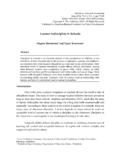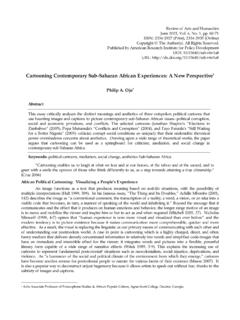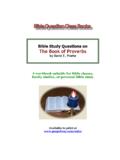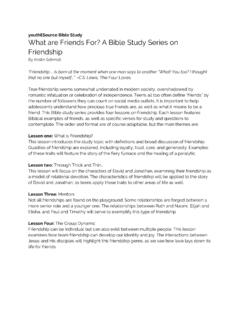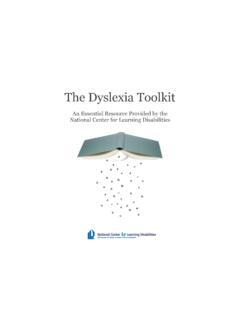Transcription of Adolescence: An Age of Storm and Stress
1 Review of Arts and Humanities, Vol. 2 No. 1, June 2013 19. Adolescence: An Age of Storm and Stress Saba Hashmi1. Abstract This research paper gives impetus on the world's adolescents growing up in the world and focuses on the areas of evaluating existing developmental models or proposing culturally based approaches to studying adolescent development; describing successful models of interventions to improve the well-being of youth; and examining how global factors are experienced locally by adolescents. Adolescence is a time of development and a roller coaster of adjustments to adult life. Much of the time, adolescents are disregarded, stereotyped, and misjudged based on their nature and age. Girls especially undergo a distressing series of events during adolescence that while uncomfortable, will eventually lead to the formation of an identity that the adolescent will have well into their adult life.
2 A myriad of factors affect the development of identity during the adolescent years, and many things can help and hinder this process. This study therefore aimed to explore how adolescents from the majority of world perceive and cope with Stress in the domains of parents, peers, and culture. Key Words: Adolescence, Transition, Metacognition, Peer Introduction The word adolescence is Latin in origin, derived from the verb adolescere, which means to grow into adulthood . Adolescence is a time of moving from the immaturity of childhood into the maturity of adulthood. Though there is no single event or boundary line that denotes the end of childhood or the beginning of adolescence yet experts think of the passage from childhood into and through adolescence as composed of a set of transitions. These transitions are biological, cognitive, social and emotional which can be turbulent time for them.
3 This age sometime referred to as teenage years, youth or puberty, occurring roughly between the ages of 10 and 20 can be broadly categorized into three stages: Early adolescents (12 to 14 years) a phase when the kid is not yet matures but he is no longer a kid. At this stage physical changes are a constant source of irritation. Middle adolescents (14 to 17 years) this phase is mark by emotional,. Cognitive mental maturity develops in early age in girls than in male. Late adolescents (17 to 19 years) finally come close to adulthood to have a firm identity and more stable interests. Adolescents are more wary about security, safety and independence. In many societies, adolescence was not recognized as a phase of life. Most societies simply distinguished between childhood and adulthood. As Stanley Hall generally described it in his 1904. study Adolescence as a developmental phase. Hall attributed the new stage to social changes at the turn of the 20th century.
4 1. Mewar University, Chittorgargh, Rajasthan, India. American Research Institute for Policy Development 20 Review of Arts and Humanities, Vol. 2 No. 1, June 2013. Child labor laws kept individuals under 16 out of the work force, and Universal education laws kept them in secondary school, thus prolonging the period of dependence- a dependence that allowed them to address psychological tasks they might have ignored when they took on adult straight out of childhood. Adolescence is a transitional stage between being a child and becoming an adult. Erik Erikson is a well-known and respected developmental psychologist, the first to coin the term identity crisis and who did a lot of work in the stages of human identity development. Two of Erikson's eight stages of development pertain directly to the concept of adolescence. From the age of five until child reaches puberty, they are involved in a stage known as industry versus inferiority.
5 During this time a child strives to gain status among their peers in order to come to terms with their personal strengths and weaknesses (Nielsen 126). Once this stage is completed, a child becomes more involved with social systems and peer groups. This leads into Erikson's identity versus confusion, which occurs all through puberty and into early adulthood. This is the time in adolescence when attitudes about sex, love, marriage, gender roles, and other important life issues are formed and become part of the individual's identity (Nielsen 126). Identity versus role confusion is the most important component and event of adolescence, and is widely determined by varying cultural and social aspects. A defining characteristic of adolescents is the participation in high-risk activities in order to rebel against their parents' wishes or expectations. This is not an entirely negative characteristic.
6 Risk-taking adolescents may be independent thinkers, have high levels of energy and confidence, and feel ultimately in control of their lives (Johnson 390). Unfortunately, a lot of the behaviors that adolescents pick up during mimesis that appear to be socially acceptable are high-risk behaviors that could become detrimental to the youth's health and wellness. Again, this is especially true for adolescent immigrant girls who are very acculturated. High levels of pregnancy among Latinas found that a high level of acculturation was related to high sexual activity accompanied with low usage of contraceptives (Johnson 138). Families represent one of the most important developmental contexts for adolescents all over the world. However, there are marked culturally based differences in adolescents' family experiences (Georgas, Berry, van de Vijver, Kagitcibasi, & Poortinga, 2006). The negotiation of adolescent autonomy, a central developmental task for adolescents in Western industrialized countries, is not as critically important in other countries (Kagitcibasi, 2005a).
7 Moreover, the importance assigned to adolescent peer culture in European and North American countries may not be paralleled in other regions of the world (Brown, Larson, & Saraswathi, 2002). Although research on adolescent coping in recent years has advanced the understanding of coping processes in close relationships (see, for a summary, Seiffge-Krenke, 2011), studies on adolescents living in non-Western developmental contexts are rare. Period of Transition Adolescence is sometime viewed as a transitional state, during which youths begin to separate themselves from their parents but still lack a clearly defined role in society. Adolescents face a range of developmental issues. He experiences a variety of biological changes, cognitive changes social changes and encounters a number of emotions. Lord Byron quotes this age in his words as So much alarmed that they are quite alarming. All giggle Blush, half pertness and half Pout.
8 American Research Institute for Policy Development Review of Arts and Humanities, Vol. 2 No. 1, June 2013 21. Physical Transition The biological transition of adolescence, or Puberty, is perhaps the most observable sign that adolescence has begun, more broadly speaking puberty is used as a collective term to refer to all the physical changes that occur in the growing girl or boy as the individual passes for childhood into adulthood. The timing of physical maturation varies widely. In the United States, menarche typically occurs around age 12, although some youngsters start puberty when they are only 8 or 9 others when they are well into their teens . The duration of puberty also varies greatly 18 months to 6 years in girls and two five years in boys. The physical changes of puberty are triggered by hormones, chemical substances in the body that act on specific organs and tissues. In boys a major change incurred during puberty is the increased production of testosterone, a male sex hormone, while girls experience increased production of the female hormone estrogen.
9 Both in boys and girls a rise in growth hormone produces the adolescent growth spurt, the pronounced increase in height and weight that marks the first half of puberty. Cognitive Transition A second element of the passage through adolescence is a cognitive transition. Compared to children, adolescents think in ways that are more advanced, more efficient and generally more complex. This is evident distinct areas of cognition. First, during adolescence individuals become better able than children to think about what is possible, instead of limiting their thought to what is real. Second, during the passage into adolescence, individuals become better able to think about abstract ideas. For example, adolescents find it easier than children to comprehend the sorts of higher order, abstract logic inherent in puns, proverbs, metaphors and analogies. This is clearly seen in the adolescent's increased facility ad interest in thinking about interpersonal relationship, politics, philosophy, religion and morality- topics that involve such abstract concepts as friendship, faith, democracy, fairness and honesty.
10 Third, during adolescence individuals begin thinking more often about the process of thinking itself or metacognition. As a result, adolescents may display increased introspection and self- consciousness. Although Improvements in metacognitive abilities provide important intellectual advantages, one potentially negative by product of these advances is the tendency for adolescents to develop a sort of egocentrism, or intense preoccupation with the self. Psychologists refer to this as the imaginary audience. A fourth change in cognition is that thinking tends to become multidimensional, rather than limited to a single issue. Being able to understand that people's personalities are not one- side, or that social situations can have different interpretations, depending o one's point of view, permits the adolescents to have far more sophisticated and complicated relationship with other people. Finally, adolescents are more likely than children to see things as relative, rather than absolute.
